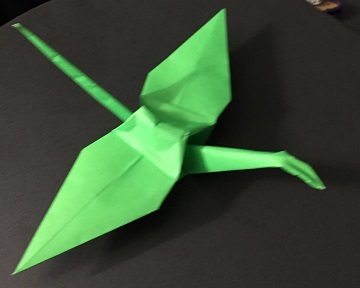This weekend's origami workshop wasn't my best ever (I picked models that were too difficult for half the people that showed up -- and didn't have a backup plan) but aside from the boy who cried, it was generally fun. The models were organized around an interesting problem: ye standard origami crane doesn't fly, because the weight isn't balanced right.

Thanks, Wikimedia
Specifically, as a rule of thumb, you want roughly 1/3 of the area of the wing in front of your airplane's center of gravity. The standard crane is symmetric, with the wings centered over the center of gravity.
There's two possible ways to adjust the model: move the wings back or move weight forward. I was planning to teach two models that did one each:

Designed by Jun Maekawa, folded by Stephane Gerard

Designed by Yoshihide Momotani, folded by myself
We did only the first before running out of time, and I forgot to photograph an example. The second pic is my demo version of the second model -- you can't tell from looking, but extra paper is folded over inside then squared off, and the results is folded into a standard crane that's front-weighted exactly right. Neither model has a brilliant glide-path angle, but they do glide, unlike the tumble of the standard crane.
TBD came to the workshop and, with Janni's guidance/assistance, successfully folded a somewhat messy standard crane -- the concept of folding an edge to an edge has clicked, even as fine motor skills aren't precise yet. Later, they asked me to teach them a simpler model, so I demoed a traditional whale while they followed along using their own piece of paper:

I was impressed.
As far as my own folding lately, aside from experimenting with bird-shaped airplanes from a couple different books, I've mostly been doing modulars, to the amusement of the engineers I work with. Details, though, are for another post.
---L.
Subject quote from "Drought," Vienna Teng.

Thanks, Wikimedia
Specifically, as a rule of thumb, you want roughly 1/3 of the area of the wing in front of your airplane's center of gravity. The standard crane is symmetric, with the wings centered over the center of gravity.
There's two possible ways to adjust the model: move the wings back or move weight forward. I was planning to teach two models that did one each:

Designed by Jun Maekawa, folded by Stephane Gerard

Designed by Yoshihide Momotani, folded by myself
We did only the first before running out of time, and I forgot to photograph an example. The second pic is my demo version of the second model -- you can't tell from looking, but extra paper is folded over inside then squared off, and the results is folded into a standard crane that's front-weighted exactly right. Neither model has a brilliant glide-path angle, but they do glide, unlike the tumble of the standard crane.
TBD came to the workshop and, with Janni's guidance/assistance, successfully folded a somewhat messy standard crane -- the concept of folding an edge to an edge has clicked, even as fine motor skills aren't precise yet. Later, they asked me to teach them a simpler model, so I demoed a traditional whale while they followed along using their own piece of paper:

I was impressed.
As far as my own folding lately, aside from experimenting with bird-shaped airplanes from a couple different books, I've mostly been doing modulars, to the amusement of the engineers I work with. Details, though, are for another post.
---L.
Subject quote from "Drought," Vienna Teng.